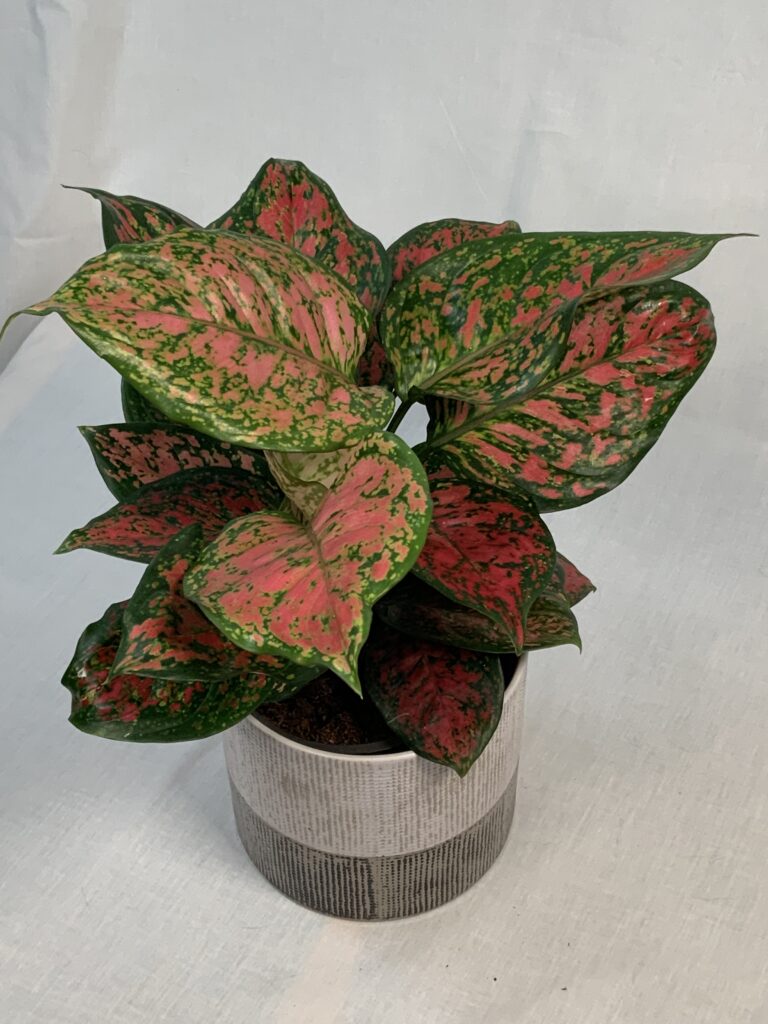No products in the basket.
Plants Blog
Aglaonema – a beautiful houseplant that is easy to grow
Aglaonema has a name that is not very easy to remember, but its cultivation is not difficult. And it’s worth taking an interest in it, because aglaonema is a pot plant with very attractive leaves.
Among the numerous potted plants grown in apartments, we can find an interesting and attractive variable aglaonema. Even though it is not as popular as the zamiokulkas, winged flowers or anthuriums belonging to the same family, it deserves our attention due to its not too high cultivation requirements and beautiful, large, green leaves, decorated with bright patterns and spots.
Aglaonema resembles dieffenbachia in appearance but has much smaller and slender leaves. Plants usually reach a height of about 80-120 cm and have a bushy, compact habit. Some of them may form a stiff shoot with age, topped with a plume of leaves.
Patterns, patterns and colours – different varieties of aglaonema
Depending on the variety, aglaonems also have more or less patterned leaves, which is why they can be very different from each other. Some, such as “Silver Queen”, “Silver Bay” or the rare in Poland “Super White” have large, green leaves, almost completely covered with a white pattern, others, such as the variety “First Diamond” produce green leaves decorated with a nice, creamy white patterned, while others, such as “Red Cochin” and “Legacy”, have very original green-white-pink solid or green-yellowish leaves with a pink border like “Crete”.
Aglaonema – from the tropics to the pot. What conditions do you need to provide?
Aglaonema comes from tropical forests, but it does quite well in an apartment and as long as a few basic conditions are met, growing it is not difficult. The plant must first of all have a bright position, but sheltered from direct sunlight, because strong sunlight has a negative effect on its development. However, it must be remembered that although it tolerates partial shade well, its colorful varieties need more light to be able to color really beautifully.
Another important thing is the right temperature. Aglaonema does not require a typical resting period and loves the heat, so it must have room temperature (20-24 ° C) all year round, which must never fall below 15 ° C.
Watering and fertilizing aglaonema
For the plant, it is also important to have the right soil and air humidity, because due to its origin it does not tolerate drought. In the summer season, it requires more intensive and quite frequent watering (on average, twice a week, the soil in the pot should be constantly slightly moist) and a regular sprinkling of the leaves. In winter, however, it prefers less frequent and less abundant irrigation (once a week or less is enough).
The same is the case with plant fertilization, which should be carried out systematically and quite often during the growing season, and completely limited in winter.
Aglaonema – planting, transplanting and reproduction
Under the right conditions, aglaonema grows nicely and create many young growths, so they should be replanted every year. Due to the shallow and extensive root system, they should be cultivated with not too high, but quite wide containers in which they will be able to grow freely and make better use of water and nutrients.
Plants should also be provided with a fertile, humus and permeable substrate with a slightly acidic pH, although they can also successfully grow without soil, as they are perfect for hydroponic cultivation. If we choose traditional cultivation, during spring transplanting, we can easily reproduce them by collecting root suckers from an adult specimen. Such seedlings usually already have their own roots, so you can immediately plant them in a new pot and place them in the target position.
Watch out for the dark side of the aglaonema
When deciding to grow agnomen, we must remember that despite all their beauty, plants also have the dark side of nature. All their parts contain very toxic juice, which, if it gets into the mouth or eyes, may cause irritation of the mucosa, and after getting into the body, seriously disturb the heart and damage the nervous system. For this reason, care work on the plant should always be carried out in protective gloves, avoiding touching the face area with a dirty hand. It is also better to give up growing the plant completely if we have small children or pets (especially cats, dogs or rodents).

